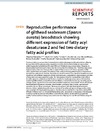Identificador persistente para citar o vincular este elemento:
https://accedacris.ulpgc.es/jspui/handle/10553/74643
| Campo DC | Valor | idioma |
|---|---|---|
| dc.contributor.author | Shajahan, Ferosekhan | en_US |
| dc.contributor.author | Xu, Hanlin | en_US |
| dc.contributor.author | Turkmen, Serhat | en_US |
| dc.contributor.author | Gómez, Ana | en_US |
| dc.contributor.author | Afonso, Juan Manuel | en_US |
| dc.contributor.author | Fontanillas, Ramon | en_US |
| dc.contributor.author | Rosenlund, Grethe | en_US |
| dc.contributor.author | Kaushik, Sadasivam | en_US |
| dc.contributor.author | Izquierdo, Marisol | en_US |
| dc.date.accessioned | 2020-10-05T08:06:16Z | - |
| dc.date.available | 2020-10-05T08:06:16Z | - |
| dc.date.issued | 2020 | en_US |
| dc.identifier.issn | 2045-2322 | en_US |
| dc.identifier.other | Scopus | - |
| dc.identifier.uri | https://accedacris.ulpgc.es/handle/10553/74643 | - |
| dc.description.abstract | Previous studies have shown that it is possible to nutritionally program gilthead seabream offspring through fish oil (FO) replacement by vegetable oils (VO) in the broodstock diet, to improve their ability to grow fast when fed low fish meal (FM) and FO diets during grow-out phase. However, in those studies broodstock performance was reduced by the VO contained diet. Therefore, the present study aimed to determine if it is possible to replace FO by a mixture of FO and rapeseed oil (RO) with a specific fatty acid profile in broodstock diets, without altering gilthead seabream broodstock reproductive performance. Besides, the study also aimed to evaluate the reproductive performance of broodstock with different expression of fatty acid desaturase 2 gene (fads2) a key enzyme in synthesis of long chain polyunsaturated fatty acids. For that purpose, broodfish having either a high (HD) or low (LD) expression of fads2 were fed for three months during the spawning season with two diets containing different fatty acid profiles and their effects on reproductive hormones, fecundity, sperm and egg quality, egg biochemical composition and fads2 expression were studied. The results showed that blood fads2 expression in females, which tended to be higher than in males, was positively related to plasma 17β-estradiol levels. Moreover, broodstock with high blood fads2 expression showed a better reproductive performance, in terms of fecundity and sperm and egg quality, which was correlated with female fads2 expression. Our data also showed that it is feasible to reduce ARA, EPA and DHA down to 0.43, 6.6 and 8.4% total fatty acids, respectively, in broodstock diets designed to induce nutritional programming effects in the offspring without adverse effects on spawning quality. Further studies are being conducted to test the offspring with low FM and FO diets along life span. | en_US |
| dc.language | eng | en_US |
| dc.relation | Consumer driven Production: Integrating Innovative Approaches for Competitive and Sustainable Performance across the Mediterranean Aquaculture Value Chain | en_US |
| dc.relation.ispartof | Scientific Reports | en_US |
| dc.source | Scientific Reports [EISSN 2045-2322], v. 10 (1), 15547, (Diciembre 2020) | en_US |
| dc.subject | 310502 Piscicultura | en_US |
| dc.subject.other | Sparus aurata | en_US |
| dc.title | Reproductive performance of gilthead seabream (Sparus aurata) broodstock showing different expression of fatty acyl desaturase 2 and fed two dietary fatty acid profiles | en_US |
| dc.type | info:eu-repo/semantics/Article | en_US |
| dc.type | Article | en_US |
| dc.identifier.doi | 10.1038/s41598-020-72166-5 | en_US |
| dc.identifier.scopus | 85091431486 | - |
| dc.contributor.authorscopusid | 55612404800 | - |
| dc.contributor.authorscopusid | 57192909946 | - |
| dc.contributor.authorscopusid | 36150331400 | - |
| dc.contributor.authorscopusid | 57191273521 | - |
| dc.contributor.authorscopusid | 57201126472 | - |
| dc.contributor.authorscopusid | 25823014800 | - |
| dc.contributor.authorscopusid | 6603100482 | - |
| dc.contributor.authorscopusid | 55421391200 | - |
| dc.contributor.authorscopusid | 7103111891 | - |
| dc.identifier.eissn | 2045-2322 | - |
| dc.identifier.issue | 1 | - |
| dc.relation.volume | 10 | en_US |
| dc.investigacion | Ciencias | en_US |
| dc.type2 | Artículo | en_US |
| dc.description.numberofpages | 14 | en_US |
| dc.utils.revision | Sí | en_US |
| dc.date.coverdate | Diciembre 2020 | en_US |
| dc.identifier.ulpgc | Sí | es |
| dc.contributor.buulpgc | BU-BAS | en_US |
| dc.description.sjr | 1,24 | |
| dc.description.jcr | 4,379 | |
| dc.description.sjrq | Q1 | |
| dc.description.jcrq | Q1 | |
| dc.description.scie | SCIE | |
| item.fulltext | Con texto completo | - |
| item.grantfulltext | open | - |
| crisitem.author.dept | GIR Grupo de Investigación en Acuicultura | - |
| crisitem.author.dept | IU de Investigación en Acuicultura Sostenible y Ec | - |
| crisitem.author.dept | Departamento de Patología Animal, Producción Animal, Bromatología y Tecnología de Los Alimentos | - |
| crisitem.author.dept | GIR Grupo de Investigación en Acuicultura | - |
| crisitem.author.dept | IU de Investigación en Acuicultura Sostenible y Ec | - |
| crisitem.author.dept | Departamento de Biología | - |
| crisitem.author.orcid | 0000-0003-4662-8306 | - |
| crisitem.author.orcid | 0000-0003-4297-210X | - |
| crisitem.author.parentorg | IU de Investigación en Acuicultura Sostenible y Ec | - |
| crisitem.author.parentorg | IU de Investigación en Acuicultura Sostenible y Ec | - |
| crisitem.author.fullName | Shajahan, Ferosekhan | - |
| crisitem.author.fullName | Xu, Hanlin | - |
| crisitem.author.fullName | Gómez Rebordinos, Ana | - |
| crisitem.author.fullName | Afonso López, Juan Manuel | - |
| crisitem.author.fullName | Izquierdo López, María Soledad | - |
| crisitem.project.principalinvestigator | Izquierdo López, María Soledad | - |
| Colección: | Artículos | |
Citas SCOPUSTM
18
actualizado el 08-jun-2025
Citas de WEB OF SCIENCETM
Citations
15
actualizado el 08-jun-2025
Visitas
318
actualizado el 12-jul-2025
Descargas
200
actualizado el 12-jul-2025
Google ScholarTM
Verifica
Altmetric
Comparte
Exporta metadatos
Los elementos en ULPGC accedaCRIS están protegidos por derechos de autor con todos los derechos reservados, a menos que se indique lo contrario.
